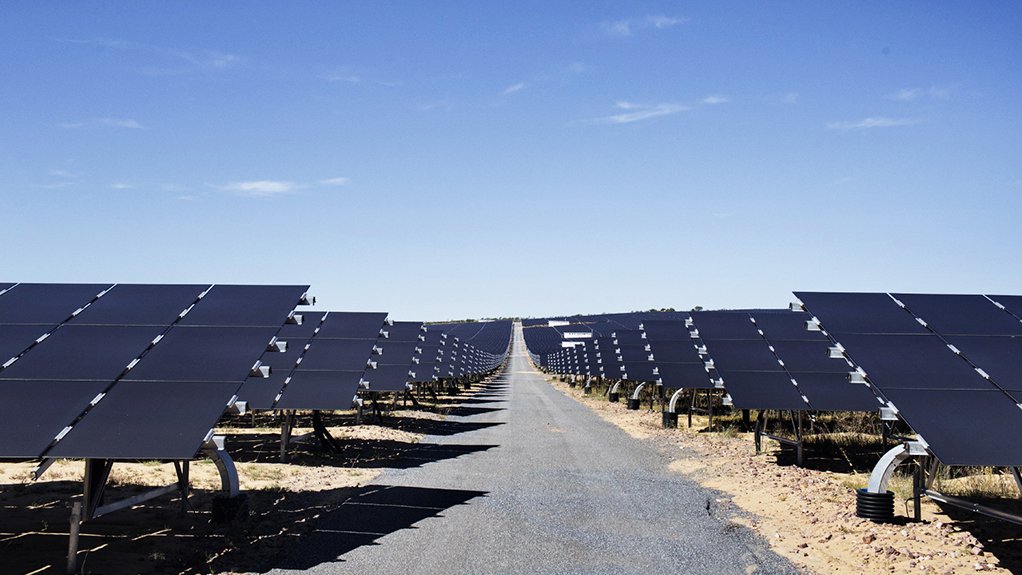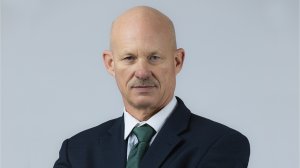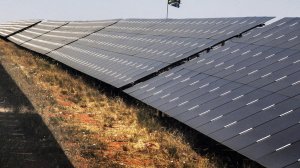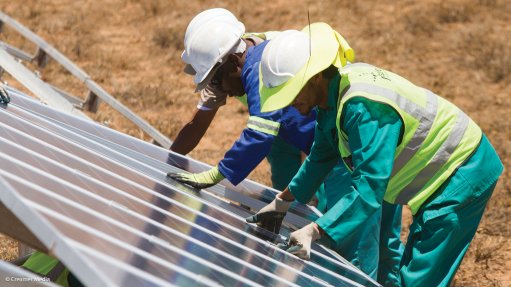Renewable energy uptake on the rise in South Africa, says Enel Green Power




Enel Green Power South Africa country manager William Price
Enel Green Power South Africa's Paleisheuwel project
Enel Green Power South Africa's Upington project
Renewable energy company Enel Green Power South Africa country manager William Price comments that, despite the delays experienced with the procurement of capacity under the Renewable Energy Independent Power Producer Procurement Programme (REIPPPP), he is not surprised by the country’s continuous project development in the renewable energy space.
He notes that this is driven by high utility price increases, the continuation of load-shedding and the ever-increasing demand for energy.
Bid Window (BW) 4 of the REIPPPP had been published for tender applications in 2015 and the initial financial close was intended for 2016, but this did not happen until 2018.
Further, the Department of Mineral Resources and Energy has only, this year, launched BW 5 of the REIPPPP.
The delay between the start of BWs 4 and 5, nonetheless, saw many development activities taking place, he tells Engineering News, as “there was a high demand for renewables and an expectation from industries and independent power producers (IPPs) that this development trajectory would continue”.
Renewable energy developers are cautiously optimistic about the announcements made by the South African government with regard to the REIPPPP, and Price says that, should everything go ahead as planned, the industry could expect to hear who the preferred bidders for BW 5 would be by the end of this year.
As it stands, responses are due in August, which would take about three months to assess. Following that, Price says financial close would likely take place only in 2022, leading to the construction of these projects.
“These [BW 5] projects would probably only go on line in 2023/24,” he comments, noting that the industry’s response to the government’s desire for more renewable energy capacity has been “quite positive and significant”, especially in the face of the country’s ongoing electricity supply challenges.
While it will still be some time before the BW 5 projects come on line, Price says BW 4 projects include several projects from Enel Green Power, which are starting to come on line.
Five of the company’s wind energy projects, collectively valued at €1.2-billion, were selected as preferred bids for BW 4. The projects have a collective nameplate capacity of 700 MW and marked an important step in consolidating Enel Green Power’s presence in Africa.
The company’s wind projects are in addition to the 323.4 MW of solar photovoltaic (PV) capacity being developed by the group in South Africa.
The total capacity of Enel Green Power’s wind projects, both in operation and under construction, in South Africa is 933.6 MW.
Its total wind and solar capacity, in operation and under construction, is 1 257 MW.
The company's wind energy projects include the 147.6 MW Oyster Bay and the 148 MW Nxuba plants, in the Eastern Cape, as well as the 142 MW Karusa, 147 MW Soetwater and 145 MW Garob plants, in the Northern Cape.
NXUBA WIND PROJECT
The Nxuba project is one of the company’s earliest BW 4 projects to be brought on line, and, if it were not for the Covid-19 pandemic, it would be “a true example of what the industry could do”, Price tells Engineering News.
The project was being put in service for 2020 when the pandemic struck, with the South African lockdown – beginning March 26, 2020 – putting commissioning on hold.
“What is unique about this particular project is that while it was producing energy to the grid, we were busy with the testing and commissioning. Since the project wasn’t commercial, we weren’t being paid for the electricity and were considered a non-essential service during the lockdown, and we had to shut down,” Price comments.
With activity on hold at the project for three months, Nxuba only reached its commercial operation date (COD) on November 24, 2020.
However, what makes the project unique in the company’s eyes is that concrete – versus steel – was used to assemble the plant’s tower sections. The towers comprise five tower sections that are made up of concrete keystones, and were poured, constructed and erected by the local community, which saw about 150 people being employed during the assembly of the tower sections.
Unlike steel towers, which are built at a manufacturing plant and transported to the project site, concrete towers are assembled on site, with all the internal pieces of the tower being installed on site too.
“It adds some complexities in that you have to deal with the weather, and you have to deal with the workers from a skills exchange and training perspective. It provides a lot more challenges because you don’t get to control the environment, as one would with a manufacturing facility,” Price explains.
Nxuba is the company’s first project using concrete towers in South Africa.
Of Enel Green Power’s other BW 4 projects under construction, the Garob and Oyster Bay projects will go on line and start producing energy to the grid in the second quarter of this year, with the scheduled COD in the third quarter.
Meanwhile, the Karusa and Soetwater projects are adjacent to one another and have a COD of the fourth quarter this year.
OPEN-ACCESS DEBATE
The government will soon be initiating the procurement of an additional 11 800 MW of power from renewable energy, natural gas, battery storage and coal in line with the Integrated Resource Plan 2019.
This means South Africa can expect additional investments going forward, says Price, who notes that despite the “starts and stops” by government over the years, development activity of projects continued.
With BW 5 now announced, the country can expect to see an additional capacity of 2.6 GW – 1.6 GW of wind energy and 1 GW of solar PV – being added.
Moreover, recent analysis suggests that easing the licensing requirements for new embedded generation projects could unlock up to 5 GW of additional capacity and help to ease the impact of load-shedding.
Price says there has been some clarity on this matter, especially from the government and Mineral Resources and Energy Minister Gwede Mantashe.
He explains that previously, regulations allowed for embedded generation, meaning projects would directly provide to businesses, but only projects producing under 1 MW could continue without licensing.
According to recent clarifications from the Minister, Price says, licences are “not necessarily required” if the energy is being used solely by the business, and there are no requirements from the utility.
While this move is a helpful one for the industry, Price suggests that open access to transmission would allow the renewable energy sector to provide and do more, given it is not always convenient to develop a renewable energy project next to a large energy-consuming business.
Should this change occur, he says this would “open up opportunity” for multiple technologies, and see technologies being combined, to create opportunities for both large- and small-scale generation.
“It wouldn’t be just the large-scale projects that could provide energy, and the availability of projects would be larger,” he notes, adding that smaller scale projects and even IPPs would be able to contribute to energy and electricity requirements on the basis of there being open access to transmission.
Comments
Announcements
What's On
Subscribe to improve your user experience...
Option 1 (equivalent of R125 a month):
Receive a weekly copy of Creamer Media's Engineering News & Mining Weekly magazine
(print copy for those in South Africa and e-magazine for those outside of South Africa)
Receive daily email newsletters
Access to full search results
Access archive of magazine back copies
Access to Projects in Progress
Access to ONE Research Report of your choice in PDF format
Option 2 (equivalent of R375 a month):
All benefits from Option 1
PLUS
Access to Creamer Media's Research Channel Africa for ALL Research Reports, in PDF format, on various industrial and mining sectors
including Electricity; Water; Energy Transition; Hydrogen; Roads, Rail and Ports; Coal; Gold; Platinum; Battery Metals; etc.
Already a subscriber?
Forgotten your password?
Receive weekly copy of Creamer Media's Engineering News & Mining Weekly magazine (print copy for those in South Africa and e-magazine for those outside of South Africa)
➕
Recieve daily email newsletters
➕
Access to full search results
➕
Access archive of magazine back copies
➕
Access to Projects in Progress
➕
Access to ONE Research Report of your choice in PDF format
RESEARCH CHANNEL AFRICA
R4500 (equivalent of R375 a month)
SUBSCRIBEAll benefits from Option 1
➕
Access to Creamer Media's Research Channel Africa for ALL Research Reports on various industrial and mining sectors, in PDF format, including on:
Electricity
➕
Water
➕
Energy Transition
➕
Hydrogen
➕
Roads, Rail and Ports
➕
Coal
➕
Gold
➕
Platinum
➕
Battery Metals
➕
etc.
Receive all benefits from Option 1 or Option 2 delivered to numerous people at your company
➕
Multiple User names and Passwords for simultaneous log-ins
➕
Intranet integration access to all in your organisation




















